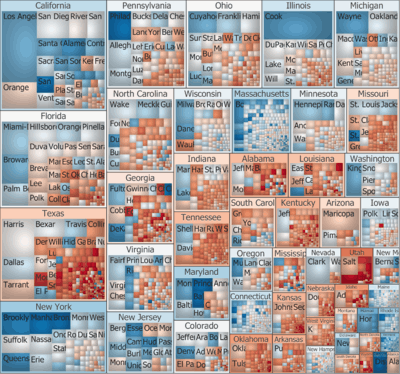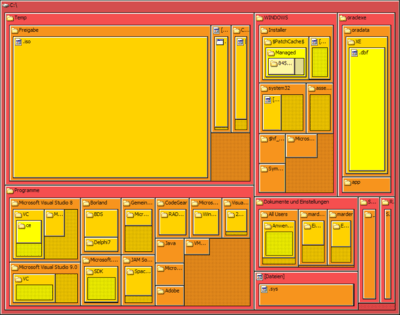Treemapping




In information visualization and computing, treemapping is a method for displaying hierarchical data by using nested rectangles.
Main idea
Treemaps display hierarchical (tree-structured) data as a set of nested rectangles. Each branch of the tree is given a rectangle, which is then tiled with smaller rectangles representing sub-branches. A leaf node's rectangle has an area proportional to a specified dimension of the data. Often the leaf nodes are colored to show a separate dimension of the data.
When the color and size dimensions are correlated in some way with the tree structure, one can often easily see patterns that would be difficult to spot in other ways, such as if a certain color is particularly relevant. A second advantage of treemaps is that, by construction, they make efficient use of space. As a result, they can legibly display thousands of items on the screen simultaneously.
The tiling algorithm
To create a treemap, one must define a tiling algorithm, that is, a way to divide a rectangle into sub-rectangles of specified areas. Ideally, a treemap algorithm would create rectangles with an aspect ratio close to one, furthermore preserve some sense of the ordering in the input data, and change to reflect changes in the underlying data. Unfortunately, these properties have an inverse relationship. As the aspect ratio is optimized, the order of placement becomes less predictable. As the order becomes more stable, the aspect ratio is degraded.
To date, six primary rectangular treemap algorithms have been developed:
| Algorithm | Order | Aspect ratios | Stability |
|---|---|---|---|
| BinaryTree | partially ordered | high | stable |
| Mixed Treemaps[2] | ordered | lowest | stable |
| Ordered | partially ordered | medium | medium stability |
| Slice And Dice | ordered | very high | stable |
| Squarified[3] | unordered | lowest | medium stability |
| Strip | ordered | medium | medium stability |
In addition, several algorithms have been proposed that use non-rectangular regions:
- Jigsaw Treemaps[4] - based on the geometry of space-filling curves
- GosperMaps[5] - based on the geometry of Gosper curves, [ordered, very high Aspect ratio, stable]
- Voronoi Treemaps[6] - based on voronoi diagram calculations
- Convex Treemaps[7] - convex polygons are used instead of rectangles
- Circular Treemaps - circles are used instead of rectangles
History
Area-based visualizations have existed for decades. For example, mosaic plots (also known as Marimekko diagrams) use rectangular tilings to show joint distributions (i.e., most commonly they are essentially stacked column plots where the columns are of different widths). The main distinguishing feature of a treemap, however, is the recursive construction that allows it to be extended to hierarchical data with any number of levels. This idea was invented by professor Ben Shneiderman at the University of Maryland Human – Computer Interaction Lab in the early 1990s.[1] Shneiderman and his collaborators then deepened the idea by introducing a variety of interactive techniques for filtering and adjusting treemaps.
These early treemaps all used the simple "slice-and-dice" tiling algorithm. Despite many desirable properties (it is stable, preserves ordering, and is easy to implement), the slice-and-dice method often produces tilings with many long, skinny rectangles. In 1994 Hascoet & Beaudouin-Lafon invented a "squarifying" algorithm, later popularized by Jarke van Wijk, that created tilings whose rectangles were closer to square. In 1999 Martin Wattenberg used a variation of the "squarifying" algorithm that he called "pivot and slice" to create the first Web-based treemap, the SmartMoney Map of the Market, which displayed data on hundreds of companies in the U.S. stock market. Following its launch, treemaps enjoyed a surge of interest, especially in financial contexts.
A third wave of treemap innovation came around 2004, after Marcos Weskamp created the Newsmap, a treemap that displayed news headlines. This example of a non-analytical treemap inspired many imitators, and introduced treemaps to a new, broad audience. In recent years, treemaps have made their way into the mainstream media, including usage by the New York Times.[8][9] The Treemap Art Project produced 12 framed images for the National Academies (United States), shown the Every AlgoRiThm has ART in It exhibit in Washington, DC and another set for the collection of Museum of Modern Art in New York.

See also
- Disk space analyzer
- Information visualization
- List of countries by economic complexity, which includes a list of Products Exports Treemaps.
- Marimekko Chart, a similar concept with one level of explicit hierarchy.
References
- 1 2 Ben Shneiderman; Catherine Plaisant (June 25, 2009). "Treemaps for space-constrained visualization of hierarchies ~ Including the History of Treemap Research at the University of Maryland". Retrieved February 23, 2010.
- ↑ Roel Vliegen; Erik-Jan van der Linden and Jarke J. vanWijk. "Visualizing Business Data with Generalized Treemaps" (PDF). Retrieved February 24, 2010. Cite uses deprecated parameter
|coauthors=(help) - ↑ Bruls, Mark; Huizing, Kees; van Wijk, Jarke J. (2000). "Squarified treemaps". In de Leeuw, W.; van Liere, R. Data Visualization 2000: Proc. Joint Eurographics and IEEE TCVG Symp. on Visualization (PDF). Springer-Verlag. pp. 33–42{{inconsistent citations}}.
- ↑ Wattenberg, Martin (2005). "A Note on Space-Filling Visualizations and Space-Filling Curves". In Stasko, John T.; Ward, Matthew O. IEEE Symposium on Information Visualization (InfoVis 2005), 23-25 October 2005, Minneapolis, MN, USA (PDF). IEEE Computer Society. p. 24{{inconsistent citations}}.
- ↑ Auber, David; Huet, Charles; Lambert, Antoine; Renoust, Benjamin; Sallaberry, Arnaud; Saulnier, Agnes (2013). "Gosper Map: Using a Gosper Curve for laying out hierarchical data". IEEE Transactions on Visualization and Computer Graphics. 19 (11): 1820–1832. doi:10.1109/TVCG.2013.91. PMID 24029903{{inconsistent citations}}
|contribution=ignored (help). - ↑ Balzer, Michael; Deussen, Oliver (2005). "Voronoi Treemaps". In Stasko, John T.; Ward, Matthew O. IEEE Symposium on Information Visualization (InfoVis 2005), 23-25 October 2005, Minneapolis, MN, USA (PDF). IEEE Computer Society. p. 7{{inconsistent citations}}.
- ↑ Krzysztof Onak; Anastasios Sidiropoulos. "Circular Partitions with Applications to Visualization and Embeddings". Retrieved June 26, 2011.
- ↑ Cox, Amanda; Fairfield, Hannah (February 25, 2007). "The health of the car, van, SUV, and truck market". The New York Times. Retrieved March 12, 2010.
- ↑ Carter, Shan; Cox, Amanda (February 14, 2011). "Obama's 2012 Budget Proposal: How $3.7 Trillion is Spent". The New York Times. Retrieved February 15, 2011.
External links
| Wikimedia Commons has media related to Treemaps. |
- Treemap Art Project produced exhibit for the National Academies in Washington, DC
- An article by Ben Shneiderman on the use of treemaps (as a guest on www.perceptualedge.com )
- Comprehensive survey and bibliography of Tree Visualization techniques
- Generalized treemaps
- History of Treemaps by Ben Shneiderman.
- Hypermedia exploration with interactive dynamic maps Paper by Hascoet and Beaudouin-Lafon introducing the squarified treemap layout algorithm (named "improved treemap layout" at the time).
- Indiana University description
- Live interactive treemap based on crowd-sourced discounted deals from Flytail Group
- Treemap sample in English from The Hive Group
- Several treemap examples made with Macrofocus TreeMap
- Visualizations using dynamic treemaps and treemapping software by drasticdata
- Product Exports Treemaps developed by the Harvard-MIT Observartory of Economic Complexity
- newsmap.jp is a treemap of Google news stories